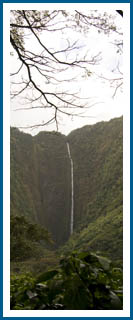
 |
 |
Field Updates: March 2004 Student Account (by Kay Fullerton)First group of student scientists collect baseline data in the field! Some of the students walked into the valley, while others, along with teachers and scientists, drove in 4-wheel drive vehicles. The "home base" was the old Araki Hotel located not too far in to the valley at the Hi'ilawe Stream road crossing. The participating scientists included: Ron Englund, David Preston and Myra McShane, scientists from Bishop Museum, and John Kahiapo, education specialist of Hawaii Division of Aquatic Resources. Stream Flow - measuring the total amount of water flowing in the stream by using a staff rod and flow meter to measure stream depth and velocity at specific points. Water Quality - instruments were used to take water temperature, dissolved oxygen levels, conductivity and turbidity. Habitat Mapping - stream width was measured at regular intervals, and stream habitats were measured to determine total amount of slow (pool), medium (run), and fast (riffle/cascade) habitats.  Random Sampling of Insects - insects were collected using the "Surber" method of sampling, at points along the stream randomly selected. At the end of the day, students went to the estuary where the stream meets the ocean. John explained the importance of the estuary and the migration of Hawaii's native stream fish and invertebrates down to the ocean (as larvae) and back up the stream (as juveniles). He caught some juvenile o'opu and put them on a device that he invented to observe their upstream migration behavior. Small trickles of water are run down the side of a small plexi wall; the fish are placed in a trough at the bottom of the wall, and they begin climbing up the trickles of water. Holding on with their pelvic fins, the fish make their way to the top of the wall! Finally, some students went swimming in the ocean and a picnic dinner at the beach was enjoyed by all! Top of Page |
|
| Copyright © Hawaii Biological Survey, Bishop Museum Site last updated January 2010 |
||